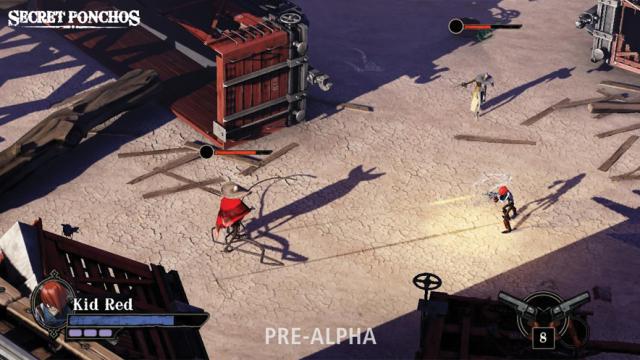Secret Ponchos features outlaws. It features guns, it features shootouts, it features eight-on-eight free-for-alls. It features exactly one poncho, however, and zero secrets. So what’s in its name?
“When we started work on the game we put up a development blog, and we needed a name for it,” said Caley Smyth, a developer for Switchblade Monkeys, the developing studio. “Secret Ponchos” was its code name, Smyth explained. The team is basically a group of friends (with some big-time industry experience on their resumés) working all over North America, so “Secret Ponchos,” became more than a central information hub on their project, it became shorthand for the game, coming in the first half of 2014 to PlayStation 4.
“When it came time to decide, everyone was like, ‘Really guys? This is what we’re going with?’ But it just fit because it’s what we’d called it all along.” Smyth said. “I know it doesn’t make sense; well, the argument is Donkey Kong doesn’t make sense either, right?” Smyth laughed. Secret Ponchos seemed to fit because it’s what everyone had been calling it all along.
Describing the game itself also comes in an elusive, tip-of-the-tongue way. It’s class-based, but you wouldn’t call it a class based shooter because that implies a view closer than the Diablo-esque isometric angle. Multiplayer shooter also seems to communicate something else, even though that’s essentially what it is (there is no campaign mode to Secret Ponchos.)
The classes themselves also don’t hew to the mainstays of multiplayer shooters. For example, what would figure to be the game’s sniper has a long range sniper shot, with the familiar aim-down-sights control on R1 acting somewhat as a charge-shot that also increases his range. But “The Deserter” is one of the slowest of the six classes because his standard fire causes the most damage. You must aim with the right stick in order to take a shot with R2, which makes moving and shooting — and sniping with The Deserter — an all-hands task that takes some getting used to. Considering the damage The Deserter can deal with his charge shot, this kind of challenge seems necessary.
While the game may not have a singleplayer campaign mode, it does feature some role-playing elements that support a broad story of vying against rivals to become the most wanted outlaw in the west. The duels you have, whether one-on-one, in teams of two or four, or in an eight-man free-for-all, acquire experience points that progress your character through a perk tree and unlock customisation options. “Blood bets,” a method of wagering your experience points, can make it worthwhile for newcomers to take on high-level opponents, in hopes of getting lucky and bringing them down for a huge payoff. If you lose enough XP to drop a level, you will, losing whatever perk that came along with it.
In my hands-on, I played “Domination,” a two-on-two race to see who could get five kills first. But many other matches in the game’s playlist won’t feature respawning. Smyth said the design team wanted to capture the feeling of the one-versus-many showdowns featured in so many of the spaghetti westerns the team loves (and which inspired the project.)
Originally, the game was to have been a truer third-person shooter with a camera angle closer to the player. Smyth said the team found players were dying about as quickly as they usually do in other third- and first-person multiplayer shooters, making the no-respawn matches too fast to be enjoyable. So they backed the camera out to its high-angle view, but still left in a means of surprise. A player running from another who manages to break his pursuer’s line of sight will actually disappear from the screen.
The game’s maps are set in the fictional town of Lonetree, a prototypical backwater terrorised by lawlessness. In addition to the Deserter, the characters are Gordo, whose gatling gun has a high rate of fire but poor damage and poor range (range is represented by a line extending in the direction your character is facing). The Killer is an all-rounder and will be the preferred class for newcomers. The Matador, the game’s lone female, was just introduced; I didn’t see or play with her in my runthrough; Kid Red is the game’s speedy class, with low health. But if he gets close enough to a foe, he can strap dynamite to them — they’re helpless to do anything other than try to catch Red or his teammate in the blast. (You can see all of the classes and their base attributes here.)
And finally, there’s Phantom Poncho who deals about as much damage as the Deserter and is faster, but has midrange health. He is the only character who wears the game’s namesake.
“When we were trying to come up with names, it was always something like ‘Renegade Revolvers,’” Smyth said, making a face. “Everybody was coming up with something generic.” Plenty of words could describe a game like this, but “generic” isn’t one of them.

Comments